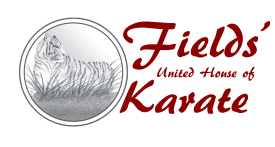to Shotokan Karate & Fields’ Karate Dojo
Sensei Profile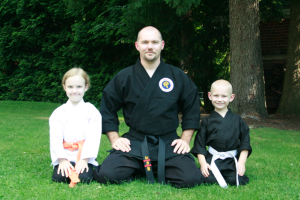
Sensei Sid Fields has been studying and practicing Shotokan Karate for 30 years and teaching for over 25 of those years. He earned his first degree black belt in 1999 at the age of 13, his second degree in 2004, and his third degree in October 2015. One of the greatest lessons Sensei Sid learned after earning his black belt is that earning a black belt is really just a beginning in Karate. Today, Sensei Sid continues to train and learn advanced Karate himself, learning most as he teaches and trains others in Karate.
Raised in Callahan, FL, Sensei Sid began studying under Sensei Bruce Coppen, who became the primary father figure in Sensei Sid’s life and continues to be even today. Sensei Bruce and Sensei Sid’s Church family filled many substantial voids, especially spiritual voids, in his troubled growing up years. Sensei Sid desires to do something of the same for other youth and young adults. This is part of the reason for the existence of Fields’ Karate. To this end, Sensei Sid has also served in youth and young adult ministries in local Churches over the last 10 years as both a youth pastor and layman.
The Nature of Shotokan Karate
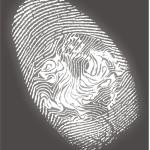 Shotokan Karate is a traditional, empty-handed, defensive, Okinawan martial art using blocks and strikes with the arms, hands, feet, knees, and elbows as our primary means of defense. At Fields’ Karate we incorporate elements of Judo, Aikido, military, police, and traditional weapons training.
Shotokan Karate is a traditional, empty-handed, defensive, Okinawan martial art using blocks and strikes with the arms, hands, feet, knees, and elbows as our primary means of defense. At Fields’ Karate we incorporate elements of Judo, Aikido, military, police, and traditional weapons training.
While Shotokan is a method and training in physical conflict, it is much more than that. Our founder, Funakoshi, said of the nature of Karate,
“True Karate-do is this: that in daily life, one’s mind and body be trained and developed in a spirit of humility; and that in critical times, one be devoted utterly to the cause of justice.”
Teaching & Training Philosophies
Every style of Karate, every dojo, and every instructor has a philosophy, or guiding set of principles, that shape how a sensei teaches Karate. In Shotokan and at Fields’ Karate we teach theory and train in practicality. We ingrain philosophy and live in conviction.
This means the instructor is not just a coach, teacher, or trainer; he is Sensei. Students are not just athletes, pupils, or trainees; they are karateka. And our facility is not just a gym, school, or training center; it is a dojo.
Each of these statements has implications reflecting the philosophies of Shotokan and Fields’ Karate and guide the training that happens there.
Our sessions are structured around three training methods: kata, kihon, and kumite.
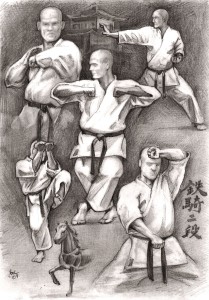 Kata, or ‘forms,’ are the most formal method and are the focus at Fields’ Karate. Kata are individually performed, prearranged sets of techniques that simulate a fight.
Kata, or ‘forms,’ are the most formal method and are the focus at Fields’ Karate. Kata are individually performed, prearranged sets of techniques that simulate a fight.
Kihon, also known as ‘floor movement’ or ‘basic training,’ is a set of techniques determined by the sensei, executed together as a class on the sensei’s call.
Kumite, or ‘sparring,’ is an engagement match that could be any of several different types that involve a partner standing in as an opponent.
Within these methods of training we drill on techniques. Properly executing techniques repetitiously, even to the point of exhaustion, creates a muscle memory converting techniques into natural reactions.
Within these methods of training we concentrate on the details. Details make the difference between losing and prevailing; between health and injury; between success and failure.
Within these methods of training we master techniques. Karateka do not progress in rank or technique until they have satisfactorily mastered the techniques they have been given. No contract, payment, or time in training constitutes a right to promotion. All promotions are skill based and at the discretion of Sensei.
Within these methods of training we train each other. Advanced karateka are often charged with teaching lower ranks. This causes advanced karateka to pay closer attention to the details of their own techniques, prepares them for a future role as a sensei, and makes available a broader range of teaching methods for lower ranks.
Within these methods of training we maintain self-control. It is not necessary for karateka to take heavy contact in regular, weekly training sessions. There are appropriate times where heavier contact is used, but not until karateka are adequately prepared.
Within these methods of training we develop physical fitness and conditioning. There is much benefit to great strength; there is more benefit to great technique. Neither can be achieved without fitness and conditioning.
Benefits of Karate Training
There are any number of benefits and advantages to Karate training, surely too many to list here exhaustively. However, there are three benefits worthy of particular note. Karate training lends itself to athletic exercise, self-defense, and character training.
Karate training provides uniform training for the entire body such that no part is disproportionately under or over developed. It provides for excellent cardio-vascular and strength-building exercise. Many karateka who were weak in childhood developed into extraordinary athletes and martial artists.
Because of increased blood circulation and joint movement, karateka with chronic ailments and arthritis pain often find relief as their training progresses. Karateka have even been able to reduce or altogether stop medications for chronic ailments because of their Karate training.
Karate training provides for an excellent means of self-defense. Proficient karateka are capable of defeating larger, stronger opponents when necessary. Children are able to stop bullies, women are able to thwart attackers, and the elderly are able to prevent would-be robbers.
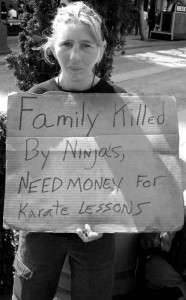 Many ignorant of Karate have laid the claim that Karate is useless in a real street fight. This is categorically untrue. It is more common for practitioners of true Karate to walk away from a conflict, one way or another, than not. This is the aim of Karate as self-defense.
Many ignorant of Karate have laid the claim that Karate is useless in a real street fight. This is categorically untrue. It is more common for practitioners of true Karate to walk away from a conflict, one way or another, than not. This is the aim of Karate as self-defense.
Those laying this claim also fail to recognize that Karate was developed during a period of time when weapons were banned for the commoner and by a people who perfect everything they put their effort to. Further, most karateka do not have to put their physical abilities to use because their other virtues developed through Karate training help to prevent trouble before it begins. This is the true essence of Karate.
Karate training provides for character development. Funakoshi emphasizes that Karate training fosters “the traits of courage, courtesy, integrity, humility, and self-control in those who have found its essence.”
Such character development provides benefits to every area of life. Children concentrate and behave better in school. Adults become more efficient and focused at work. Parents have more patience with their children. And everyone builds a level of confidence and self-control only found among karateka.
Sensei has personally trained youth who have reduced and even ceased taking their behavior modification medications because their Karate training gave them a structured environment and physical outlet for pent up energy, lengthened their attention spans, and taught them self-control. Frequently, children and parents find that children’s grades improve dramatically after time spent in Karate training. Sensei has experienced for himself how the confidence built in Karate training has changed him from being the target of bullies to a defender of those bullied.
The benefits and advantages to Karate training continue on from here and are sometimes particular to each karateka. We encourage you to speak with other karateka and the parents of children training in Karate. You will find a limitless nature to these benefits.
Benefits of Karate Training at Fields’ Karate Dojo
Each of the benefits of Karate training will be found at Fields’ Karate. These benefits can also be found in many dojos. This begs the question of what is special about Fields’ Karate. There are a few points to consider:
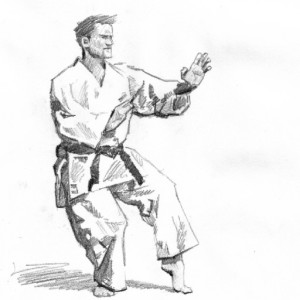 Traditional Teaching. Fields’ Karate teaches a traditional style of Shotokan Karate using traditional, time-proven methods. This does not mean we do not progress and incorporate some new methods, but that our core teaching method still revolves around a structure of kihon, kata, and kumite.
Traditional Teaching. Fields’ Karate teaches a traditional style of Shotokan Karate using traditional, time-proven methods. This does not mean we do not progress and incorporate some new methods, but that our core teaching method still revolves around a structure of kihon, kata, and kumite.
Simple Programs. We maintain a simple program at Fields’ Karate. Each training session is focused on either children or adults and beginning ranks or advanced ranks. We do not maintain multiple programs each requiring additional costs. Sensei trains each karateka with them earning their black belt in mind.
Community Focus. Joining Fields’ Karate is not just signing up for Karate lessons. It is entering a community of martial artists dedicated to the development and growth of each other in both personal character and Karate skills. To promote this community focus, Fields’ Karate occasionally sponsors events and activities that are only loosely tied to Karate training.
Reasonable Cost. Fields’ Karate was not established primarily to turn a profit. We are not a chain or franchise business. Sensei’s desire is simply to teach Karate to those who seek to train. This allows Fields’ Karate to maintain a reasonable monthly price with no contracts or legal commitments. The only commitments involved are personal, voluntary commitments made on the part of each karateka.
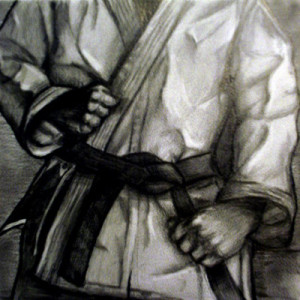 Skill-Based Promotion. No belt rank is ever given at Fields’ Karate; each karateka earns every rank. There is a certain level of skill and knowledge required for each promotion. Until a karateka demonstrates that knowledge and skill they are not permitted to promote. No time spent in training sessions or fees paid entitle a karateka to promotion. However, time spent in training sessions and personal practice hold a direct correlation to developing skill and knowledge.
Skill-Based Promotion. No belt rank is ever given at Fields’ Karate; each karateka earns every rank. There is a certain level of skill and knowledge required for each promotion. Until a karateka demonstrates that knowledge and skill they are not permitted to promote. No time spent in training sessions or fees paid entitle a karateka to promotion. However, time spent in training sessions and personal practice hold a direct correlation to developing skill and knowledge.
Experienced Instruction. Sensei has been teaching Shotokan Karate for over 15 years. He has taught hundreds of children and adults, men and women, and even some with physical handicaps and learning disabilities. Sensei has sat on numerous boards for several dozen black belt candidate tests. You will find a competent instructor in Sensei.
Misconceptions of Who Trains in Karate
There is a misconception that only children take Karate lessons. The most dedicated karateka are usually adults and many of them begin their training as adults.
Another misconception is that only people who can’t do anything else learn Karate. The most naturally talented karateka are often young adults and those who have a background in other sports or activities, especially dance, gymnastics, and soccer. It is not uncommon for these karateka to train in Karate in the off season of their other sport. Of course, this slows their progression in ranking.
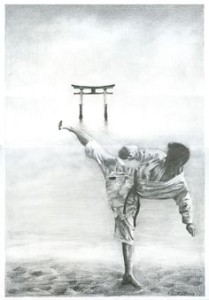 A third misconception is that only fit and highly athletic people can begin Karate training. Extensive fitness is not a prerequisite of Karate training; it is the product of Karate training. Plenty of karateka begin their training with no athletic background. It is not unusual for someone over weight to begin training, though it is unusual for them not to lose some of that weight.
A third misconception is that only fit and highly athletic people can begin Karate training. Extensive fitness is not a prerequisite of Karate training; it is the product of Karate training. Plenty of karateka begin their training with no athletic background. It is not unusual for someone over weight to begin training, though it is unusual for them not to lose some of that weight.
Further, many karateka who otherwise lean toward academia versus athletics find themselves well-suited to Karate training. There is a very technical aspect to Karate they often find fascinating.
So, the fact of the matter is anyone with a mind and the will to train in Karate may do so. There is no “type” of person that Karate training is exclusive toward.
Dangers of Karate Training
As with any physical activity there is a level of risk of physical injury in Karate training. It would seem logical to expect greater numbers of worse injuries in Karate training than other, mainstream sports, such as basketball, baseball, or soccer. This is true of the more aggressive combat martial arts styles including Krav Maga, MMA, Boxing, Muy Thai, Kick Boxing, and others.
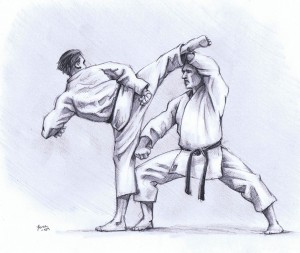 Because Shotokan Karate is a defensive style the risk of injury is similar to that of mainstream sports and is often less dangerous. A good sensei is very conscious of the injury risks of Karate training and limits the likelihood of those injuries.
Because Shotokan Karate is a defensive style the risk of injury is similar to that of mainstream sports and is often less dangerous. A good sensei is very conscious of the injury risks of Karate training and limits the likelihood of those injuries.
At Fields’ Karate we recognize each karateka has limitations that must be pushed and expanded. We also know that doing so too quickly can cause undue injury. We maintain highly structured training sessions, not allowing for unsupervised horse-play. When karateka train directly with a partner in drills, one-points, take-downs, or free sparring, light contact is required, especially for lower ranks and younger karateka. These are some of the ways we mitigate injuries in training.
It is essential to understand, however, that there is a risk of physical injury in Karate training. There is no promise that even children will not be at all injured. In fact, Sensei has never promoted a karateka to black belt who has not had at least some minor injury during their years of training. This is not an unreasonable fact understanding that karateka are training to prevail in a fight.
It must also be understood that the likelihood and potential severity of injury increases with rank, experience, strength, and age. The greatest risks of injury are found among older teenagers and young adults in the brown belt ranks. But these are limited by supervision and class structures.
Thus far we have focused on the physical dangers of Karate training, which is what most potential karateka and parents are concerned about. But there are other dangers. Verbal, mental, and emotional abuse has been discovered in Karate schools before from both instructors and other karateka. These are truly sad cases. At Fields’ Karate we do not tolerate such abuse from anyone and karateka engaging in abuse are removed from the dojo.
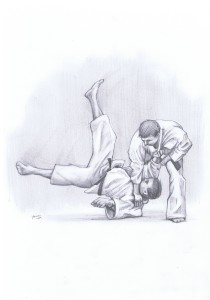 Having trained karateka for over 15 years and serving over 10 years in local Church youth ministries, Sensei is keenly aware of and sensitive to such bullying. And while Karate training is tough by nature, at Fields’ Karate karateka will find a great deal of encouragement from Sensei.
Having trained karateka for over 15 years and serving over 10 years in local Church youth ministries, Sensei is keenly aware of and sensitive to such bullying. And while Karate training is tough by nature, at Fields’ Karate karateka will find a great deal of encouragement from Sensei.
Another danger of Karate training is ridicule from those outside the dojo. Many of the general public do not understand Karate and believe it to be a “crutch” for the weak of body. Public knowledge of a karateka’s training may illicit challenges from those with superiority complexes. Even Sensei receives the occasional joke, ridicule, or challenge from someone ignorant of Karate. The key is never to give in to such things; this requires a discipline of mind and emotions that develops with time in Karate training.
Perhaps the greatest danger of Karate training is the potential for its misuse. Karateka develop skills that will have a lethal potentiality. With these skills comes great responsibility. One of Sensei’s greatest disappointments is for a karateka to achieve a brown belt rank and then drop his training. These karateka have achieved a dangerous skill level without a full understanding of that skill and the responsibility that joins it. That understanding develops greatest as the karateka nears his black belt. Funakoshi remarks of the same concern,
“The indiscriminate use of the art of karate would cause great public concern and one cannot deny its potential dangers. However, it would be regrettable that pursuit of this mysterious art…should be shunned simply because it is too dangerous…The source of concern is largely based on the misconception arising from instructors of poor character…and from the misbehavior and poor attitudes of karate students who are learning this art solely as a technique of fighting…Karate-do, improperly used, is certainly dangerous and vicious. But for the same reason that it is dangerous, karate, too if properly applied, can yield results of great value…those who would learn Karate-do must be made to understand it at the outset and be instructed in its proper use.”
Karate & Religion
The Okinawan masters of old were devout men of various religions, most prominently Buddhism. As with any devout man, their Eastern religions played a central role in every aspect of their lives. This includes their Karate training and teaching. 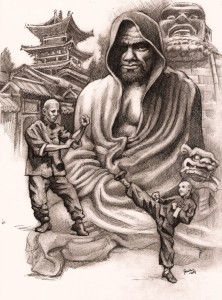 If you pay attention you will clearly see it in their writings about Karate and any other topic they address.
If you pay attention you will clearly see it in their writings about Karate and any other topic they address.
The Okinawan masters of old often attributed certain principles of Karate to their spiritual lives and that of their karateka. Today, many of these principles are best explained by physics, kinesiology, and psychology. For instance, the concept of ki or chi describes an “inner life force”. This force is said to be controlled, manipulated, and focused into techniques giving the karateka nearly supernatural power and prowess. At Fields’ Karate we understand this simply to be a focus of one’s mental and physical attention. As with anything one focuses on, such an alignment will certainly increase power and prowess, but of a very natural degree.
Some principles of Karate, namely matters of personal character and self-discipline, truly are spiritual matters. A karateka’s sense of justice, integrity, morality, and self-control arise from his spirit, regardless of his religion. The religion of each karateka will have tremendous bearing on these spiritual matters. So will his Karate training.
Fortunately, Buddhism is not the only religion compatible with Karate training. Karate is not tied to any one religion but for many religions, it reinforces the principles taught in those religions. Thus, a person from nearly any religion can become a karateka.
Your sensei’s religion will also greatly influence your Karate training and invariably will influence you personally. Sensei Sid is a devout Christian and is unapologetic about it. As such, his faith serves as the central part to every aspect of his life including his Karate training and operation of Fields’ Karate. Christian principles are taught and reinforced in training sessions, the Bible is frequently referenced, prayer is not uncommon, and the Gospel of Jesus Christ is shared openly.
This does not mean that only Christians are welcome to join Fields’ Karate; quite the opposite is true. Anyone of any peaceful religion or no religion is encouraged to train with us. But we do not want you to be unaware of who Sensei Sid is or what role his Christianity plays at Fields’ Karate.
Many wonder how a Christian can justify training in Karate, a way of fighting, while following a peaceful Christ. Truly, there is no passage of Scripture that forbids self-defense entirely. In fact, many passages of Scripture command and instruct on how martial arts are to be used for defense.
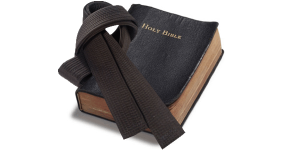 In Luke 22:36 Jesus instructed his disciples to arm themselves with swords, a means of self-defense.
In Luke 22:36 Jesus instructed his disciples to arm themselves with swords, a means of self-defense.
In Nehemiah 4:14-23 God’s people were told prepare and fight to protect themselves, their families, and their homes.
In Mark 12:31 Jesus explains that the second greatest commandment is to love one’s neighbor. This means we are to protect our neighbors, their families, and their homes too.
In Proverb 21:15 and Isaiah 1:17 God instructs us to pursue justice and correct oppression. The principle of justice is also central to Karate. Karate is to be used to promote justice and oppose oppression.
So we see that Karate is not only compatible with Christian principles, it bolsters those principles.
